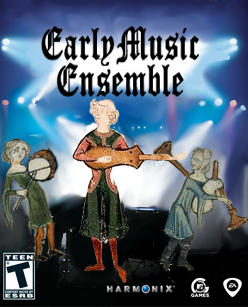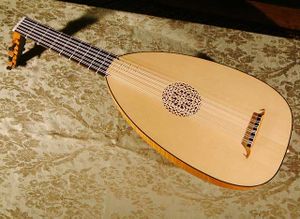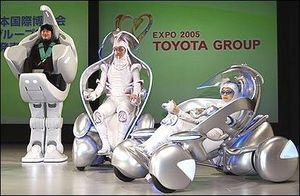Early Music Ensemble (game)
| Early Music Ensemble | |
|---|---|
| Developer(s) | Harmonix |
| Publisher(s) | MTV Games |
| Platform(s) | All of them |
| Release | June 23rd, 2008 |
| Genre | Musical Video Game |
| Mode(s) | Dorian, Phrygian, Mixolydian |
Early Music Ensemble is a video game developed by Harmonix Games Systems, published by MTV Games and distributed by EA Distribution. The game allows up to four players to perform in a virtual early music ensemble by playing four different peripherals modeled after antiquated musical instruments. It is the only cross-platform game currently available on the market: a copy of Early Music Ensemble may be played with the Nintendo Wii, PS3, Playstation 2, XBOX 360 and even older game systems such as the Sega Master System, Nintendo Entertainment System and Commodore 64.
Gameplay[edit | edit source]
Reusing many gameplay elements from the Guitar Hero and Rock Band series, Early Music Ensemble players use peripherals modeled after musical instruments to simulate the performance of music. Players must play these instruments in time with musical notes representing pitch and duration. The musical notes are represented by a new system developed by Harmonix called “music notation” -a series of dots and lines representing what notes should be played and when.
There is no point scoring system and players are free to judge the worthiness of their performance.
Instrument Peripherals[edit | edit source]
The game features special Early Music Ensemble-branded controllers modeled after period instruments. These include the EME Wireless Lute, the EME Wireless Flute, the EME Wireless Bandora and the EME Wireless Sackbut. These peripherals are constructed from authentic materials such as wood, brass and cat gut, rather than plastic. Whereas the Rock Band Wireless Fender Stratocaster consists of five buttons to simulate frets and a strumbar to simulate strings, the EME Wireless Lute has actual frets and strings which players need to tune. The other peripherals are similarily authentic, to give players a greater range of possible pitches and timbre.
Harmonix's Vice President of Product Development, Greg LoPiccolo, admits that even seasoned Rock Band veterans may find the EME peripherals difficult to use. However, by using an in-game technique called “practice”, bad players may become good. To enter practice mode, players need only pick up their peripherals and play repetitive exercises and scales for hours and hours for several years.
Customization[edit | edit source]
Character customization is taken to a new level in Early Music Ensemble. While many other games allow players to create an avatar and dress them to suit, Early Music Ensemble allows players to actually dress themselves. Harmonix has developed an innovative system called "clothing", whereby players don hats, shirts, pants, dresses and shoes for gameplay. Players may even continue wearing the clothing when not playing Early Music Ensemble. While the theme of the game is medieval, Renaissance and pre-baroque, players are not restricted to outdated clothing as the game is fully compatible with modern forms of clothing available in stores.
Power-Save Features[edit | edit source]
Harmonix has incorporated several energy-saving features into Early Music Ensemble. Rather than using a monitor or television screen to convey the music notation, the game provides tracks on pieces of paper, called "sheet music". The Wireless peripherals included with the game do not require batteries or any form of recharging. Instead, they are powered by food energy provided by the players.
Early Music Ensemble does not require a game disc, or even the "on" button to be pressed on a console. Because of this, EME is the only video game currently on the market that has received an Energy Star seal of approval.
Soundtrack[edit | edit source]
Early Music Ensemble includes 58 playable tracks on sheet music, covering over 500 years of music from the medieval to pre-baroque eras. The musical styles range from the art music of concert house virtuosi to the grungier sound of the “Garage Consorts” of Seattle during the 1990's.
Featured tracks include “Joy to the Person of My Love” as made famous by the Baltimore Consort, “Greensleeves” by King Henry VIII, “Can Shee Excuse?” as made famous by Sting, "Ouer Father, Deliweur us from the Jewes" by Hildegard von Bingen and “Fa la la la la” as made famous by the Prancing Faggots. Also, the game includes 13 bonus tracks that are based on music so obscure that even Harmonix has never heard of it.
Reception[edit | edit source]
After its release on July 27, 2008, Early Music Ensemble received accolades and ten-star ratings from publications as diverse as the Harvard Crimson, the SCA's Boke of Divers Knowledge, and Deluded Asshole Magazine. The Yale Record declared, “Elation! A video game worth not just a pinch of snuff, but the whole box! My collegues and I can gather for cognac, some Early Music Ensemble, and finish off the evening with a discussion about how much better we are than you. Delight!”
The rest of society, however, has not been so kind. The game has proved unpopular amongst teenagers, children, the elderly, gamers, men and women. IGN gave the game 0.5 stars out of 10, writing, “Uhhh... this isn't a game. It's some weird instruments in a box with some sheet music. Everybody at the office has had a look at it and we don't get it. There's nowhere to plug in the instruments. When we try to play them, we sound bad. Early Music Ensemble makes us feel vaguely threatened.”
Litigation[edit | edit source]
As always happens when somebody releases a new product, shameless vampires emerge from the legal woodwork to make a buck without doing any work. In August, 2008, Harmonix was sued by Gibson Guitars, claiming that Early Music Ensemble violated its intellectual property, specifically U.S. Patent Number #103982756278. Under scrutiny from defense lawyers, it was revealed that Gibson's patent was for a "device where you do stuff and things happen". The case was thrown out of court on August 27, 2008, but Gibson's lawyers looked so sad that the bailiff gave them bus fare for the trip home.
In September of 2008, EA, MTV and Harmonix were sued by Phil and Alicia Jones of Newark, NJ, for damages done to their son Dakota. According to court transcripts, ten-year-old Dakota became obsessed with Early Music Ensemble and cut off his testicles so he could be like his hero, the famous castrato singer Baldassare Ferri (1610-1680). The case is still unresolved, as no judge has been able to successfully hear the prosecution's case without pointing and laughing at the claimants.
Financial Success[edit | edit source]
As of January, 2009, Early Music Ensemble has sold only 109 units worldwide. However, programming costs have apparently been minimal and Harmonix has paid virtually nothing to license the music, which is public domain. At $10,000 per unit, costs have easily been recouped. Product returns have been absolutely refused, no matter how much customers weep or threaten the company. Due to the success of Early Music Ensemble and Rock Band, Harmonix has announced the release of two sequels due in 2010: String Quartet and Symphony Orchestra.




